The delights of the Suffolk coast
September 21st, 2020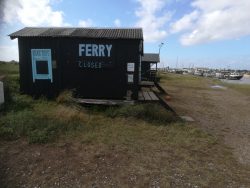
Walberswick Ferry
Hidden gems
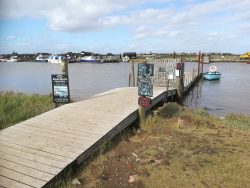
Walberswick Ferry jetty
Suffolk is a beautiful county with gentle hills, unspoiled heather land, wild forests, a delightful coastline and a rich history. Places such as Southwold and Aldeburgh are relatively well known but Walberswick, Dunwich, Minsmere and Thorpeness are hidden gems. The coastal villages offer stylish pubs serving fresh fish usually caught at Lowestoft and ready to eat on the same day. There is an attractive old fashioned sea side atmosphere without the distraction of amusement arcades but acres of sand dunes and little water ponds where families gather to fish for crab. Children can safely play football or cricket on the beach or the grass wasteland.
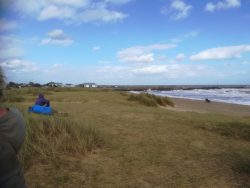
Heath land between Southwold and Walberswick
Wonderful Walberswick
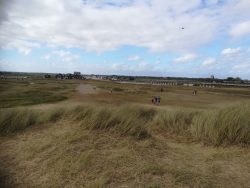
Nature reserve at Walberswick
Walberswick is about an hour’s walk from Southwold across semi marshland. At the harbour area there is a ferry that operates most days in the summer linking Southwold to Walberswick. The ferry crosses the River Blyth at the estuary point. When I used it the young woman pulling the oars had 10 passengers in the boat and managed her load with apparent ease. It is only a few yards across the river but the oarswoman has to go with the flow of the river so the journey takes a little longer than the distance suggests.
The history of Walberswick
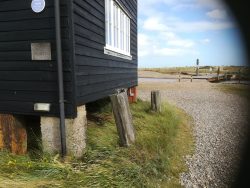
Wooden house on stilts
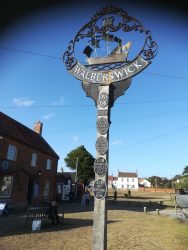
Walberswick village centre
We are staying in an old lodge converted into modern apartments about two and a half miles from Walberswick. The old lodge is next to a farm and at night there is complete darkness which is an unusual delight. At about 5am we are awoken by the crowing cock which despite the early hour is a pleasant sound. The walk to the village is across heath land dotted with sheep doing their best to keep down the overgrown grass. We meet other walkers and many with dogs. Some are travelling to Southwold but most find their way to the pretty village centre of Walberswick.
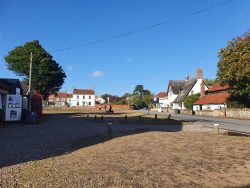
Walberswick village green
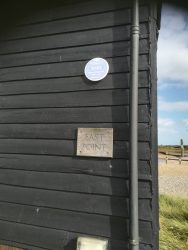
Plaque in memory of Wally Webb
There is a a village green in the centre which is often occupied with families sitting on benches and the grass to eat their picnic or an ice cream. Down at the beach are a number of black wooden houses supported by stilts. This is essential as the area is regularly flooded as witnessed by ourselves when the adjacent car park became flooded. Hopefully the stranded cars were successfully rescued by their owners.
In Medieval times Walberswick was a prosperous town due to trade and ship building. In the 15th century a large church, St Andrews was built but by the 17th century this had been replaced by a much smaller church due to Walberswick’s shrinking population.
Today there is a wooden bridge from the the wooden houses to the beach. This is a popular crabbing area and there is a plaque on one of the wooden houses to commemorate Wally Webb who helped to save the bridge and popularize the crabbing spot.
The sand dunes of Dunwich
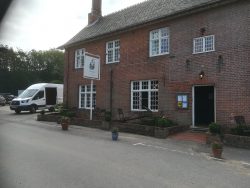
The Ship Inn, Dunwich
Dunwich is about eight miles south of Walberswick by road but a lot nearer if you were to walk there directly. Before the summer of 2020 I had visited this area a number of times before but somehow only discovered this village now by accident. There is a little wooden cafe next to beach which is packed with tourists as there is the offer of 2 meals for one. The temperature is only about 20 degrees centigrade but a number of people are braving the sea for a swim and a paddle. The sand dunes are littered with scrubs of grass which give the beach a gentle but wild feel.
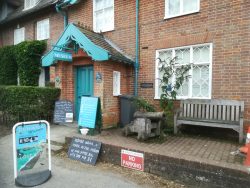
The museum at Dunwich
The local museum
The local pub, The Ship Inn, is a popular place to eat and provides accommodation for visitors who want to stay overnight. All the rooms offer en suite facilities and some with views of the marsh. The food is delicious. When we ate here we had trout served with locally grown vegetables and it was our best meal of our stay in Suffolk. Just down the road from The Ship Inn is the local museum.
The museum has a modest frontage but inside is a treasure trove of history. It tells the story of how a great medieval port disappeared into the sea and became what it is today, with just a few fishing boats and a population of about 120 people. All the family will love this museum with a video room and a model village of what the place was like in the 11th century when it was the 10th largest town in England. There are lots of pictures portraying Dunwich over the centuries and a display of objects and clothes used over the years.
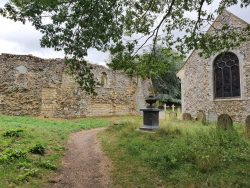
Dunwich Church
A pandemic from an earlier age
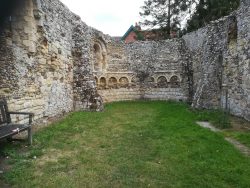
The ruins of Dunwich Leper Chapel
Leprosy is an infectious disease much feared in the middle ages. Wealthy people gave money for the care of lepers and this is how the chapel in the Dunwich became a hospital for lepers which was established in the reign of Richard 1st in 1206. The lepers had to live away from everyone else. Unlike the victims of the coronavirus who recover from their illness they lived the rest of their lives isolated from the rest of society. Today we are having to wear masks when we visit shops and social distance when out and about. Some of us who have been medically diagnosed as vulnerable are also having to self isolate. This however is nothing like the plight of those suffering from leprosy and living in accommodation such as Dunwich chapel.
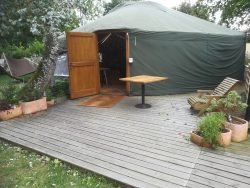
The cafe at Potton Hall
The perfect place for a coffee
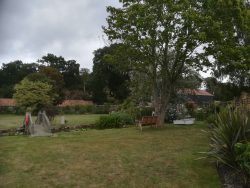
Garden at Potton Hall
Just a few miles south from Dunwich you will find Potton Hall a Spa and Health Club. There is a sign on the main road to say the cafe is open and you discover this idyllic setting. The cafe is an upmarket yurt with fantastic African paintings adorning the canvas walls. As well as being a spa and health club it also features recording studios. This would seem the ideal location for this facility as it is so quiet in a beautiful landscaped garden. It is the perfect place to stop for a coffee. Click here to find out more.
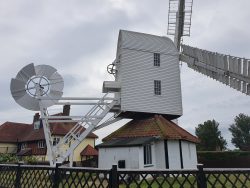
Thorpeness windmill
Where to stop for a picnic
Thorpeness is just north of Aldeburgh and can be approached via a lovely walk along the sands; depending on how fit you are it will probably take you about an hour to do this on foot. On arrival you will discover a delightful boating lake full of beautiful bird life. It is ideal for the family who can hire a rowing boat or have a picnic or treat themselves to an ice cream. A visit to the local windmill which is 10 minutes walk from the lake is also a useful way to walk off the calories acquired from eating your picnic.
Thorpeness Windmill is a Grade II listed post mill. It was built in 1803 in Aldringham and moved to Thorpeness in 1923. Originally built as a corn mill and converted to a water mill on arrival at Thorpeness.
Other coastal towns well worth a visit include Orford. Although at the time of writing the National Trust nature reserve there is closed. However Minsmere nature reserve which is run by the Royal Society for the Protection of Birds (RSPB) is open to the public. It is well worth a visit and is located in Saxmundham just south of Dunwich to find out more click here.

